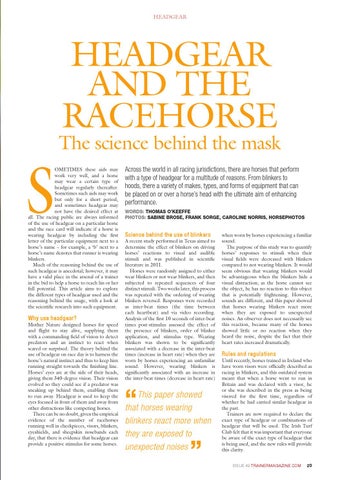HEADGEAR
HEADGEAR AND THE RACEHORSE
S
The science behind the mask
OmETImES these aids may work very well, and a horse may wear a certain type of headgear regularly thereafter. Sometimes such aids may work but only for a short period, and sometimes headgear may not have the desired effect at all. The racing public are always informed of the use of headgear on a particular horse and the race card will indicate if a horse is wearing headgear by including the first letter of the particular equipment next to a horse’s name – for example, a ‘b’ next to a horse’s name denotes that runner is wearing blinkers. much of the reasoning behind the use of such headgear is anecdotal; however, it may have a valid place in the arsenal of a trainer in the bid to help a horse to reach his or her full potential. This article aims to explore the different types of headgear used and the reasoning behind the usage, with a look at the scientific research into such equipment.
Why use headgear?
mother Nature designed horses for speed and flight to stay alive, supplying them with a commanding field of vision to detect predators and an instinct to react when scared or surprised. The theory behind the use of headgear on race day is to harness the horse’s natural instinct and thus to keep him running straight towards the finishing line. Horses’ eyes are at the side of their heads, giving them 340-degree vision. Their vision evolved so they could see if a predator was sneaking up behind them, enabling them to run away. Headgear is used to keep the eyes focused in front of them and away from other distractions like competing horses. There can be no doubt, given the empirical evidence of the number of racehorses running well in cheekpieces, visors, blinkers, eyeshields, and sheepskin nosebands each day, that there is evidence that headgear can provide a positive stimulus for some horses.
EUROPEAN TRAINER ISSUE 49 HEADGEAR.indd 29
Across the world in all racing jurisdictions, there are horses that perform with a type of headgear for a multitude of reasons. From blinkers to hoods, there a variety of makes, types, and forms of equipment that can be placed on or over a horse’s head with the ultimate aim of enhancing performance. WORDS: THOMAS O’KEEFFE PHOTOS: SAbinE bROSE, FRAnK SORgE, CAROLinE nORRiS, HORSEPHOTOS
Science behind the use of blinkers
A recent study performed in Texas aimed to determine the effect of blinkers on driving horses’ reactions to visual and audible stimuli and was published in scientific literature in 2011. Horses were randomly assigned to either wear blinkers or not wear blinkers, and then subjected to repeated sequences of four distinct stimuli. Two weeks later, this process was repeated with the ordering of wearing blinkers reversed. Responses were recorded as inter-beat times (the time between each heartbeat) and via video recording. Analysis of the first 10 seconds of inter-beat times post-stimulus assessed the effect of the presence of blinkers, order of blinker application, and stimulus type. Wearing blinkers was shown to be significantly associated with a decrease in the inter-beat times (increase in heart rate) when they are worn by horses experiencing an unfamiliar sound. However, wearing blinkers is significantly associated with an increase in the inter-beat times (decrease in heart rate)
“
This paper showed that horses wearing blinkers react more when they are exposed to unexpected noises
”
when worn by horses experiencing a familiar sound. The purpose of this study was to quantify horses’ responses to stimuli when their visual fields were decreased with blinkers compared to not wearing blinkers. It would seem obvious that wearing blinkers would be advantageous when the blinkers hide a visual distraction; as the horse cannot see the object, he has no reaction to this object that is potentially frightening. However, sounds are different, and this paper showed that horses wearing blinkers react more when they are exposed to unexpected noises. An observer does not necessarily see this reaction, because many of the horses showed little or no reaction when they heard the noise, despite the fact that their heart rates increased dramatically.
Rules and regulations
Until recently, horses trained in Ireland who have worn visors were officially described as racing in blinkers, and this outdated system meant that when a horse went to run in Britain and was declared with a visor, he or she was described in the press as being visored for the first time, regardless of whether he had carried similar headgear in the past. Trainers are now required to declare the exact type of headgear or combinations of headgear that will be used. The Irish Turf Club felt that it was important that everyone be aware of the exact type of headgear that is being used, and the new rules will provide this clarity. ISSUE 49 TRAINERMAGAZINE.COM
29
28/03/2015 12:05
